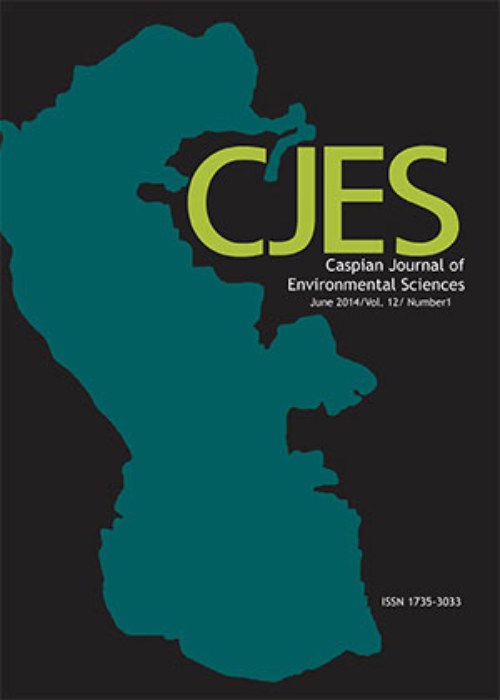فهرست مطالب
Caspian Journal of Environmental Sciences
Volume:4 Issue: 2, Spring 2006
- تاریخ انتشار: 1385/12/10
- تعداد عناوین: 7
-
Page 92The impact of PGF2? on total proteins، free amino acids and the amino transferases in the gonads of silkworm، Bombyx mori L. were investigated in the present experiment. The effect of PGF2? resulted in increase in the total protein and free amino acid contents in the gonads of silkworm larvae indicating improved structural and dynamic levels of organization. The enhanced activity levels of amino transferases and glutamate dehydrogenases (GDH) in the gonads suggest the mobilization of amino acids for glycogen synthesis or protein synthesis or both.
-
Page 98The co-inoculation of mulberry with phosphate solubilizing micro-organisms, nitrogen fixing bacteria and arbuscular mycorrhiza has influenced its macronutrient uptake through leaf. The data revealed that maximum nitrogen (484.12 kg /ha) , phosphorus (59.83 kg /ha) and potassium (244.61 kg/ha) uptake through leaf has taken place due to co-inoculation treatments as compared to the un inoculated treatments irrespective of different levels and sources of fertilizer. Significantly higher effective rate of rearing (ERR, 95.33%), single cocoon weight (2.06 g) and single shell weight (0.44 g) were recorded by feeding silkworm with the leaves harvested from the treatment T8 receiving 175 kg nitrogen and 70 kg phosphorus/ha/yr with rock phosphate as a source of phosphorus and co-inoculated with beneficial micro-organisms. Maximum filament length of 936.33 meter per cocoon and reel ability of (86%) was also recorded in the treatment T8.
-
Effect of Feeding Mulberry Leaves Supplemented with Calcium Chloride on Biochemical Contents of the SilkwormPage 110Oral Supplementation with 50, 100 and 150 ?g/ml calcium chloride to the fifth stadium larvae of CSR2xCSR4 biovoltine hybrid silkworm, B. mori on fat body glycogen, protein, and total lipids and haemolymph trehalose and protein have been studied. One of the four normal feeds per day was substituted with treated leaves fed to silkworms at fifth instar larvae. The controls were fed with the leaves dipped in distilled water and normal leaves. The fat body glycogen with 50 and 100 ?g/ml, haemolymph trehalose with 100 and 150 ?g/ml and fat body protein with all the calcium chloride treated groups were increased significantly when compared over respective carrier controls. There was significant increase in the haemolymph protein with 150 ?g/ml calcium chloride treated group. However, there was no significant change in the haemolymph protein with 50 and 100 ?g/ml calcium chloride treated groups when compared over the respective carrier controls. The fat body total lipids decreased significantly in all the groups treated with calcium chloride when compared over the respective carrier controls. These results indicated that the content of glycogen and protein of the far body and trehalose and protein content of the haemolymph to calcium chloride showed good response in CSR2xCSR4 bivoltine hybrid silkworm, B. mori.
-
Page 132The projected rainfall change under various scenarios is likely to have both positive and negative implications on agriculture and water supply because in rainfall pattern across the country. Rise in rainfall is seen over all states except Punjab, Rajasthan and Tamil Nadu, which show slight decrease in precipitation in the future scenarios. Marked increase in covering the Western Ghats and northwestern peninsular India including Maharastra and the adjoining parts of Andrapradesh, Madhyapradesh and Karnataka. The annual maximum peak in the sub basin of Mahanadi has exceeded from the present level of about 20000 cumecs under control scenario to a maximum level of 37000 cumecs under Green House Gas (GHG) scenario, such an increase in flood peak may be detrimental to a large number of existing structures on these drainage system. The number of drought weeks has considerably increased during GHG scenario barring about five sub basins out of the 21-sub basins of Krishna.
-
Page 142A total of 3528 specimens of freshwater turtles belonging to two families viz., Geoemydidae (Brown River Turtle, Kachuga smithi; Indian Saw-backed turtle, K. tecta; Brahminy Rrive Turtle, Hardella thurgi; Spotted Pond Turtle, Geoclemys hamiltonii) and Trionychidae (Indian Soft-shell Turtle, Aspederates gangeticus; Peacock Soft-shell Turtle, A.hurum; Narrow-headed Soft-shell Turtle, Chitra indica; Indian Flap-shell Turtle, Lissemys punciata) were identified. Kachuga smithi (43.62%) and K.tecta (42.06%) had abundant population status, whereas, Hardella thurgi (0.88%) and Chitra indica (0.54%) were rare. Capturing of turtles for supply to foreigners and export is a major threat to these animals. Fishermen also kill them during fishing. Canal closure and de-silting is also harmful to turtles. It is concluded that it is necessary to provide immediate legal protection/coverage to all turtle species under the Punjab Wildlife Act, 1974, Pakistan; otherwise turtle species will become extinct.
-
Page 148Organotin compound that have at least one Sn-C bond have wide commercial applications as PVC stabilizer, antifouling agent in paint and as agrochemicals. The general formula for organotin compounds is R4SnX4 - n where R is normally alkyl or aryl groups and X=Cl-, OH-, CH3COO- . If n=3, the compound has the highest toxicity, for example Et3SnOAC has LD 50 4mg/Kg ( rats ) and this is the most toxic compound. Organotin compounds affect natural killer (NK) on lymphocytes in human. It is known NK lymphocyte is the primary immune defense mechanism against tumor and virtually infected the cell in human bodies. Organotin compounds pollute water and soil that can be transferred to human body through seafood. Despite the ongoing legislative restrictions for the use of Organotin compounds in Western Countries, environmental pollution of these compounds is still a big problem. Therefore the investigation on the analysis and the degradation of these compounds in water and sediments is important. In this paper, we present the challenges in the analysis and the degradation of Organotin compounds.


